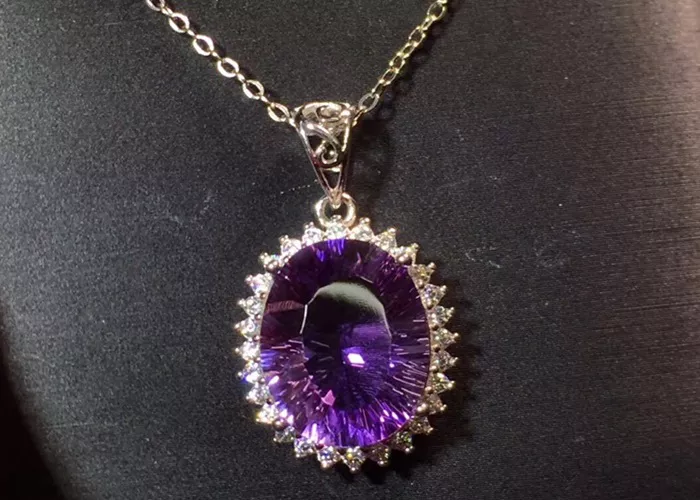Antique amethyst necklaces hold a unique allure, blending the mystique of history with the natural beauty of purple gemstones. Whether as a collector’s treasure, an heirloom, or a statement piece, their value is shaped by a complex interplay of factors ranging from the gemstone’s quality to the necklace’s historical provenance. Understanding these elements is essential for appraisers, collectors, and enthusiasts alike. Below, we explore the key determinants of value for antique amethyst necklaces in detail.
1. Gemstone Quality: The Heart of the Necklace
The amethyst itself is the centerpiece of the necklace, and its characteristics significantly influence the overall value.
Color and Hue
Depth and Saturation: Amethyst’s value traditionally hinges on its color. The most prized stones exhibit a deep, vivid purple with reddish undertones (often called “Siberian” amethyst, referencing historic Russian sources). Antique necklaces with such stones are rare and command premium prices.
Consistency: Uneven color distribution (e.g., visible zoning or pale patches) may lower value, though some collectors appreciate natural variations as markers of authenticity.
Historical Preferences: In the 19th century, lighter lavender tones were fashionable in Victorian sentimental jewelry, so such shades may hold historical value even if less intense.
Clarity and Transparency
Inclusions: Natural inclusions (e.g., mineral traces or “tiger stripes”) are common in antique amethysts. While heavy inclusions can reduce value, minor flaws may be acceptable if they don’t detract from beauty.
Treatments: Heat-treated or dyed stones were uncommon in pre-20th-century jewelry. Modern treatments to enhance color or clarity can diminish the value of an antique piece if detected.
Cut and Carat Weight
Period-Specific Cuts: Antique amethysts were often hand-cut in styles like rose cuts, table cuts, or cabochons. For example, Georgian-era necklaces might feature rose-cut stones with flat backs, while Art Deco pieces may showcase geometric step cuts.
Size: Larger stones are generally more valuable, but proportions must align with the necklace’s design. A massive amethyst in a delicate Edwardian setting might seem incongruous and lower appeal.
2. Metalwork and Setting: Craftsmanship as Art
The metal framework of the necklace is equally critical, reflecting the skill of the jeweler and the aesthetics of its era.
Metal Type and Purity
Gold vs. Silver:
Gold: Higher-karat gold (e.g., 18K or 22K) in Victorian or Edwardian necklaces increases value. Gold’s durability also ensures better preservation.
Silver: Sterling silver was widely used in mourning jewelry or mid-tier Victorian pieces. Tarnishing is common, but well-preserved silver with intricate engraving can still be valuable.
Vermeil or Gilding: Gold-plated silver (vermeil) was popular in the 19th century. Intact gilding adds value, but worn-off plating may require disclosure.
Design and Craftsmanship
Handmade vs. Machine-Made: Hand-forged filigree, repoussé work, or granulation (e.g., in Arts and Crafts movement pieces) signify superior craftsmanship. Industrial-era machine-stamped settings are less prized.
Style Eras:
Victorian (1837–1901): Romantic motifs like floral clusters, serpent designs (symbolizing eternity), or acrostic arrangements.
Art Nouveau (1890–1910): Fluid, nature-inspired forms with enamel or plique-à-jour accents.
Art Deco (1920–1935): Geometric patterns, bold contrasts, and Egyptian Revival elements.
Complexity: Multi-strand designs, detachable pendants, or convertible necklaces (e.g., doubling as a tiara) add functional and artistic value.
3. Historical Provenance: The Story Behind the Stone
A necklace’s history can elevate it from a beautiful object to a cultural artifact.
Documented Origins
Maker’s Marks: Hallmarks or signatures from renowned jewelers (e.g., Fabergé, Tiffany & Co., or regional workshops like Czech Bohemian artisans) boost value. For example, a necklace stamped with the British crown mark for sterling silver (lion passant) confirms authenticity.
Ownership History: Provenance linked to notable figures (e.g., royalty, socialites) or events (e.g., a Victorian-era exhibition) adds cachet. Auction houses like Sotheby’s often highlight such histories.
Cultural and Period Significance
Mourning Jewelry: Victorian amethyst necklaces with black enamel or hairwork compartments (popular during Queen Victoria’s widowhood) carry historical weight.
Symbolism: Amethyst was believed to ward off intoxication in ancient times and symbolized piety in ecclesiastical jewelry. Such associations enhance desirability.
4. Condition and Authenticity: Preservation Matters
Even minor damage can drastically affect value, especially for pieces over a century old.
Original Components
Unaltered Settings: Replaced clasps, added rhinestones, or restrung beads may devalue a piece. Collectors prioritize “as-made” condition.
Gemstone Integrity: Chipped or repolished amethysts reduce value unless the repair is period-appropriate (e.g., a Victorian-era foil backing to enhance brilliance).
Restoration Ethics
Professional repairs using historically accurate methods (e.g., replacing a clasp with a hand-forged replica) are acceptable. Over-polishing metal or replacing stones with modern cuts can harm authenticity.
Market Demand and Trends
Value is ultimately dictated by what collectors are willing to pay, which shifts with trends.
Current Collecting Trends
Victorian and Art Nouveau: These eras dominate the antique amethyst market due to their intricate designs and romantic appeal.
Ethical and Sustainable Fashion: Rising interest in vintage jewelry as an eco-friendly alternative to new mining drives demand.
Geographic Factors
Regional Preferences: European collectors may favor Georgian or Belle Époque designs, while U.S. buyers gravitate toward Native American or Arts and Crafts styles with amethyst accents.
Auction Performance: Recent sales of similar pieces (e.g., a $15,000 Victorian amethyst necklace at Christie’s in 2022) set benchmarks.
Rarity and Completeness
Matching Sets: A necklace with original earrings or a brooch (a “parure”) commands higher prices.
Survival Rate: Amethyst’s relative softness (7 on the Mohs scale) means many antique stones show wear. Well-preserved examples are scarce.
Conclusion
The value of an antique amethyst necklace is not merely a sum of its parts but a tapestry woven from gemology, artistry, history, and market dynamics. A Georgian gold necklace with a flawless Siberian amethyst might fetch tens of thousands, while a late-Victorian silver piece with minor repairs could appeal to entry-level collectors at a lower tier. For buyers and sellers, consulting certified appraisers, researching hallmarks, and staying attuned to auction trends are key to navigating this nuanced market. Ultimately, these necklaces are timeless bridges between the past and present, their worth measured as much in stories as in dollars.
Related topics:
Is Amethyst Truly Protective? Unveiling Its Hidden Powers
Does Amethyst Come in Different Colors?


